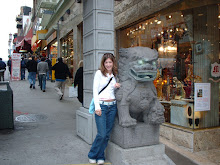I'm at a loss for relating the Baroque to my everyday world right now, so I thought I'd share some thoughts about the reading.
First, I'm having a tough time understanding when exactly Rome wasn't so (seemingly) obsessed with "the church" to need this "counter-reformation"... is the idea that they were trying to make people think that they weren't corrupt or something? I find the beginning of the chapter interesting, where Stokstad writes: "A major goal of the Counter-Reformation was to properly embellish the Church and its mother city... Unchallengeable power and vast financial resources were required to carry out such an extensive plan of urban renewal and to materially fashion Rome... The Counter-Reformation popes had great wealth, although eventually they nearly bankrupted the Church with their building plans."
Looking back to Chapter 20, Stokstad writes of the popes of the 16th century: "The popes' incessant demands for money, to finance the rebuilding of Saint Peter's as well as their self-aggrandizing art projects and luxurious lifestyles, aggraveated the relighous dissent that had long been developing." Seems to me that this "counter-reformormation" just brought more of the same... so is it just that the people weren't as upset by it all this time around? I am a bit confused.
I was also a bit confused when Stokstad wrote that Caravaggio's "important innovation was the decision to paint directly on the canvas." If everyone else wasn't painting directly on the canvas, what were they painting on?
I found Francisco de Zurbaran's Saint Serapoion quite interesting. I like the sharp contrast of the black and white and Stokstad's observation of it being "like a tragic still life." I am curious about the tag on the wall to the right of the figure... it is not addressed in the book... is it just a tag identifying him?

No comments:
Post a Comment